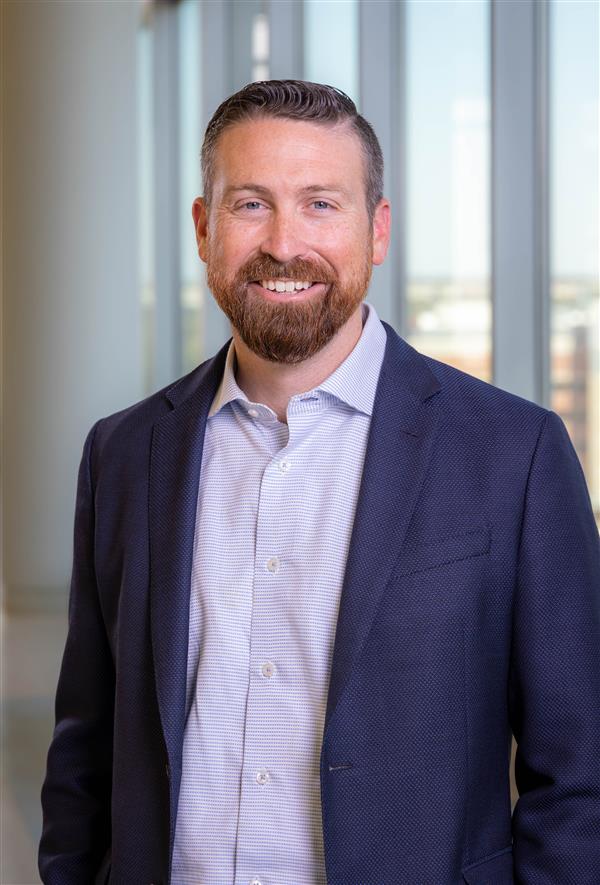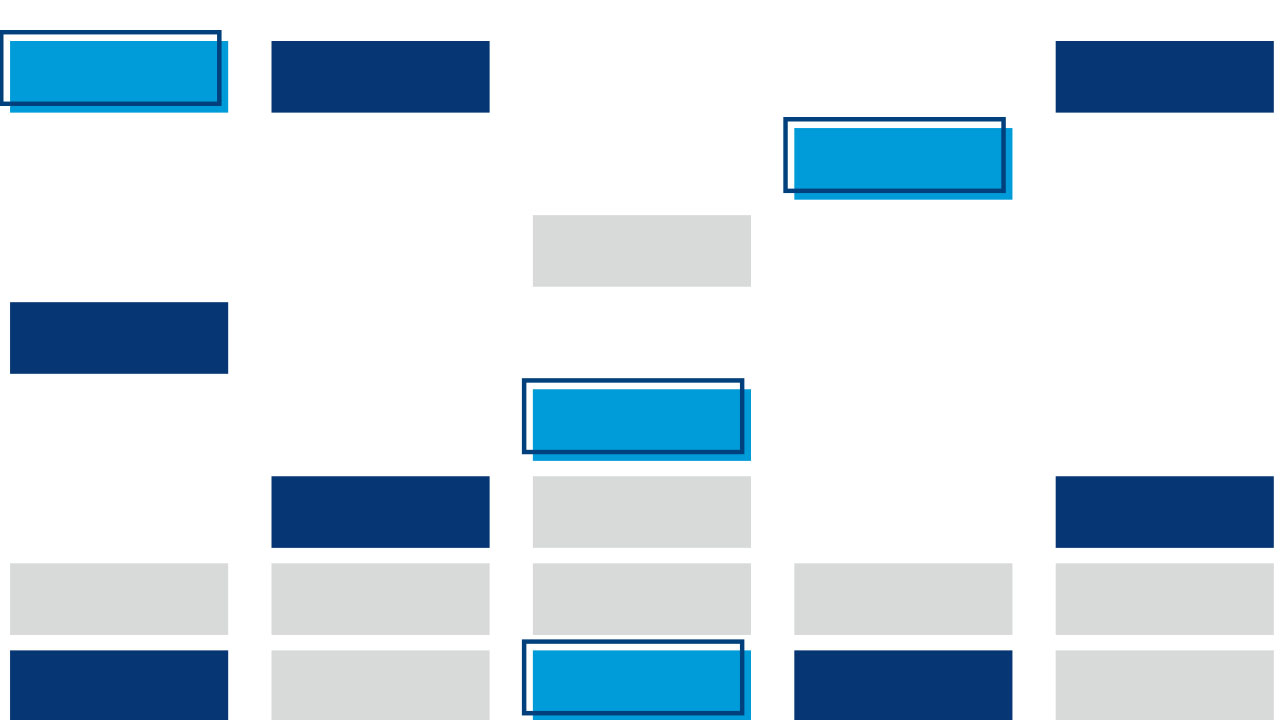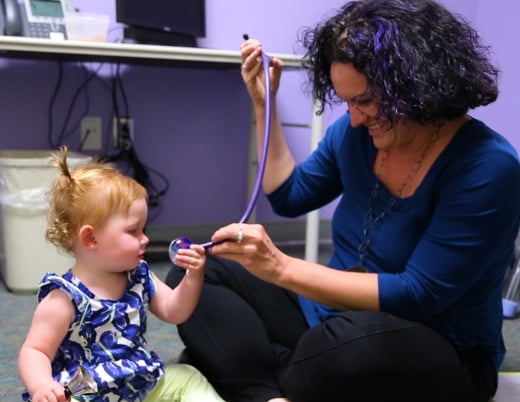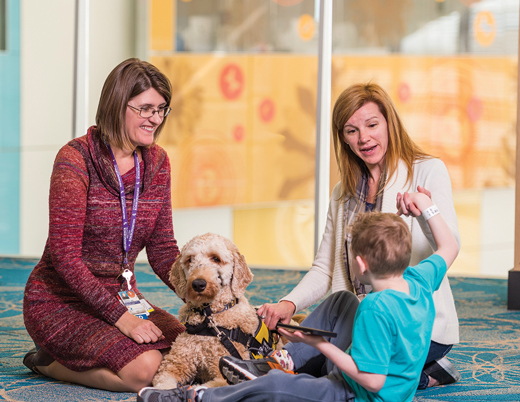How can improved infrastructure for precision medicine increase access to genetic testing and targeted treatments?
At Children’s Hospital Colorado, precision medicine has long been a key strategy for rare disease diagnosis and treatment, but access to the powerful tools behind this work has varied across programs and providers. Now, that’s changing. With the launch of the new Precision Medicine Institute, Children’s Colorado will build cross-cutting infrastructure designed to improve access to knowledge, resourcing and connectivity for all clinical areas across the organization. The overarching goal is to improve care, particularly for kids with rare diseases.
Spearheading the precision medicine effort at Children’s Colorado
Among children, rare diseases are troublingly common. In fact, according to Global Genes, a rare disease-focused organization, children are the most affected by these difficult-to-treat conditions, with about 50% of all rare diseases occurring in kids. Of that 50%, roughly 30% don’t live beyond the age of 5. For many kids, effective treatment comes down to how quickly they can get an accurate diagnosis. But pinning down these rare diseases can be an odyssey, and the average time to diagnosis is roughly seven years. During that time, families can endure misdiagnoses, mismatched treatment plans and more questions than answers.
In recent years, however, physicians have landed on a powerful medical framework that is beginning to change these statistics: precision medicine. Using genetics, environmental factors and large genomic data sets, doctors can reach a diagnosis quicker and gain a better understanding of the specific underlying causes of a child’s condition. This, in turn, allows for treatment plans targeted to each patient’s individual needs (including drugs made specially for them) and ultimately improves outcomes.
At Children’s Colorado, this precision medicine effort is led by Scott Demarest, MD, clinical director; Alisa Gaskell, PhD, scientific director; and Gregor Stoddard, administrative director. The trio thinks of the new Institute as a pillar with three key layers: diagnostics, therapeutic options and education. By joining together to direct this work, they hope to maximize the impact of each layer by expanding genetic testing for as many patients as possible, creating robust data sets to ensure that testing leads to diagnosis, and increasing available therapeutic options through drug development and repurposing, as well as broader access to clinical trials.
Importantly, this work is not solely scholarly. While research is a crucial piece of this puzzle, the team views its work as iterative in nature.
“We actually think the critical point is the junction of those two,” Dr. Gaskell says. “It’s how implementing something in clinical care can create the opportunities for additional data and learnings that can improve care. Data is only valuable if it is used.”
Precision medicine pyramid: from genomic testing to whole-exome sequencing and novel therapeutics
The team likens precision medicine to a pyramid. At the base is access to genetic and genomic testing, which typically depends on everything from insurance to what providers you’re working with and their experience. Through the new Precision Medicine Institute, the team hopes to break down some of these barriers to ensure every patient who could benefit from these tests gets them. One of the key strategies for this is to bring as much of the work in-house as possible so that it can be done quickly and under one roof. This will allow the Children’s Colorado team to maximize the expertise of clinical and technical experts.
“The vision is that a patient walks through the door and if they have a presentation that is potentially consistent with a genetic disease, we implement a comprehensive suite of genomic testing to identify exactly what’s going on with them,” Dr. Demarest says. “That immediately ties you into a database of knowledge about the implications of that diagnosis to guide our clinicians on providing exactly the right care for that patient.”
Even with tools like whole-exome sequencing, which allows doctors a detailed look at the coding material in a patient’s DNA, not every patient will receive a diagnosis. That’s why, as part of the Institute’s work, researchers aim to improve existing genetic testing options and link clinical care with research to ensure more kids get the right diagnosis and treatment.
When a patient does get a diagnosis, doctors begin by exploring existing therapeutic options. In one recent case, Dr. Demarest was tasked with treating two young girls who had persistent seizures. Typical treatments yielded minimal results. That changed once whole-exome sequencing came into play. Through that testing, Dr. Demarest discovered that both girls had a novel gene change that impeded their ability to process vitamin B6, which the team had been using to lessen their symptoms. By switching to a form of vitamin B that their bodies could easily process (and that could be readily purchased at local health stores), the team was able to completely stop the girls’ seizures, leading to significant developmental gains.
Repurposing existing supplements and drugs, like Dr. Demarest did in this case, represents the middle layer of the pyramid. But sometimes that’s not possible and doctors must move to the tip of the pyramid: novel therapeutics. In some cases that means developing a brand-new drug specifically tailored to one individual’s unique genetic makeup. That work has begun at Children’s Colorado, and the team hopes to see significant expansion as a result of the Institute’s improved precision medicine infrastructure.
“Genetic results are not just individual results. They have implications for the entire family.”
- GREGOR STODDARD
Education across the precision medicine spectrum
In addition to clinical care and research, the Precision Medicine Institute is dedicated to education in multiple forms. That education starts with patients and families, as such information is incredibly personal and can have rippling effects.
“Genetic results are not just individual results. They have implications for the entire family,” Stoddard says. “There is a level of ethical responsibility we have in a consideration of the entire family unit that we want to bring to bear as we’re integrating this into standard clinical practice.”
The team also aims to serve as an educational resource for providers and researchers everywhere, ensuring they have access to information on available tools and how they can be used to pinpoint a patient’s therapeutic needs.
“Education really serves as the glue that makes this all happen together,” Stoddard says. “If you build all the best infrastructure, but people don’t know how to utilize it and it’s not being put into practice, then you’re not getting anywhere.”
Health equity and genetic testing
This work has the potential to make a measurable impact on rare disease outcomes, improving and saving lives like never before. But the Children’s Colorado precision medicine team has found themselves asking important questions about whose lives are being impacted and why.
“We mapped the human genome for the first time in 2008 and since then, there’s been a tremendous amount of advancement in this space, but we have oversampled individuals from Western European descent. So, we know a lot of things, but we know them largely about certain patient populations,” Dr. Gaskell says. “We have a moral imperative not only to ensure that when you need genetic testing within our organization, you get it, but also that we are appropriately testing patients of all backgrounds to inform our knowledge base going forward.”
In placing a clear, intentional emphasis on equity and embarking on a dedicated effort to improve access to genetic testing for kids from minoritized communities, backgrounds and socioeconomic statuses, the team hopes to contribute to overarching knowledge. This will not only allow doctors to better treat kids who visit Children’s Colorado, but also help patients across the globe.
“Part of this is increasing our knowledge of minority groups and what their genetics and genomics look like,” Stoddard adds. “In minority groups, we have a much harder time because we just don’t have a strong database behind those patient populations.”
That goal, like the others driving the creation and implementation of the Precision Medicine Institute, is big and will require focused effort. But for Dr. Demarest and the rest of the team, this work is crucial in building an entirely new approach to medicine that will ensure all patients receive the very best care possible. He hopes that one day precision medicine won’t be the “medicine of the future” — it’ll just be medicine.
Three studies in precision medicine
Vision precision
Children’s Colorado ophthalmologist Emily McCourt, MD, is using precision medicine to slow the progression of retinitis pigmentosa in an 11-year-old patient who also has an accompanying rare disease known as posterior column ataxia. Through genetic testing, Dr. McCourt and her team discovered a rare intronic mutation that is sometimes treatable with genetic therapy. Working with the n-Lorem Foundation and a colleague at Boston Children’s Hospital, Dr. McCourt helped create a customized treatment, known as an antisense oligonucleotide, targeting this patient’s particular mutation. Laboratory testing yielded encouraging results, and the drug, made just for this patient, will soon gain FDA approval so the team can begin treatment.
Reshaping the statistics
Treating patients with relapsed Ewing sarcoma and osteosarcoma remains a clinical challenge, with fewer than 20% of diagnosed patients surviving beyond the age of 5. Previous bone cancer research has shown that abnormal activity of kinases (specialized proteins that transfer signals and provide function) may play an important role. Emily Blauel, MD, is working to better understand this using precision medicine. These kinases can be blocked by a class of drug called multitargeted tyrosine kinase inhibitors. Dr. Blauel’s research aims to fill gaps in knowledge between genomic aberrations in the tumor and abnormal activity of kinases. With this data, she hopes to improve targeted use of multitargeted tyrosine kinase inhibitors to tailor this therapy for each individual patient.
Hunting for clues
Working together, Taizo Nakano, MD; Annie Kulungowski, MD; and Aparna Annam, DO, are gaining a better understanding of vascular anomalies, or complex conditions resulting from malformations or tumors of the vascular systems. Precision medicine has allowed the team to identify two key pathways that drive the development and progression of these conditions: RAS/MAPK and AKT/PIK3CA/ mTOR. By repurposing drugs that inhibit these pathways, the Vascular Anomalies Center can provide targeted treatments for functionally devastating vascular anomalies. For example, mTOR inhibitors initially designed to treat immune disorders are now standard therapy for lymphatic malformations, and the group recently completed clinical trials on a PIK3CA inhibitor, originally designed to treat breast cancer, that has been repurposed to treat complex PIK3CA-related overgrowth syndromes. While these two pathways don’t provide all the answers to the underlying causes of vascular anomalies, they do give doctors a place to focus their future explorations.
Featured Researchers

Alisa Gaskell, PhD
Scientific Director
Precision Medicine Institute
Children's Hospital Colorado

Scott Demarest, MD
Pediatric neurologist, clinical director
Precision Medicine Institute
Children's Hospital Colorado
Associate professor
Pediatrics-Neurology
University of Colorado School of Medicine





 720-777-0123
720-777-0123










